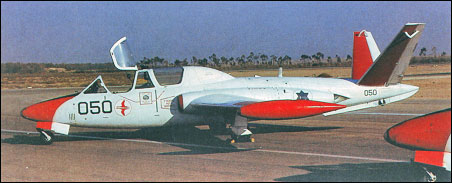 |
Aerospatiale (Fouga) CM.170 Magister / CM.175 Zephyr1952 |  |
| TRAINER, LIGHT ATTACK AIRCRAFT | Virtual Aircraft Museum / France / Aerospatiale |
 |
In its time one of the most widely used trainer/light attack aircraft, the Aerospatiale CM.170 Magister (first produced by Air Fouga and then by Potez) was designed to meet an Armee de I'Air requirement for a jet trainer (the first in the world). The prototype made its maiden flight on 23 July 1952, and a pre-production batch of 10 was ordered the following year. An initial order of 95 for the Armee de I'Air was placed in 1954 and the first production aircraft flew on 13 January 1954. Since then over 400 Magisters have been produced for the Armee de I'Air alone. A specially-equipped naval version was produced for the Aeronavale, designated CM.175 Zephyr. Two prototypes and 30 production aircraft were built to this standard, and the Zephyr provides naval pilots with their initial experience of operating from an aircraft-carrier. In addition to French-manufactured Magisters offered for export, the trainer was manufactured under licence in West Germany by Flugzeug-Union-Sud for Luftwaffe training schools. However, with the transfer of most German flying training to the United States by the end of the 1960s, the Magister was phased out of service. Valmet OY in Finland built 62 Magisters under licence (in addition to 18 purchased from France) and Israel Aircraft Industries also acquired manufacturing rights for the type, building many for light-tactical use as well as training. Total production was 916 aircraft. The Magister is all-metal. The mid-mounted wings have single-slotted flaps and airbrakes. The butterfly-type tail has surfaces separated by 110°. Fuel is housed in two fuselage tanks of 255-litre and 475-litre capacity, with wingtip tanks each holding 125 litres. The tandem cockpits are pressurised and air-conditioned, with individually regulated oxygen supplies. Ejection seats are not fitted. VHF, blind flying equipment and radio compass are standard in the trainer, while UHF, Tacan and IFF may be fitted to armed Magisters. Armament combinations include two 7.5mm or 7.62mm machine-guns mounted in the nose, with 200 rounds of ammunition per gun. A gyro gunsight is fitted in both cockpits, the rear one having periscopic sighting. Underwing ordnance loads include two Matra Type 181 pods each with eighteen 37mm rockets, two launchers each mounting seven 68mm rockets, four 25kg air-to-ground rockets, eight 88mm rockets, two 50kg bombs, or two Nord AS.11 air-to-surface guided missiles. About 310 Magisters of the 437 originally procured remained in service with the Armee de I'Air until the mid-1980s. A 150-hour basic flying training course was provided for commissioned pupils at the Ecole de I'Air at Salon-de-Provence, and similar instruction was provided for other ranks at Groupement Ecole 315, Cognac. Magisters also served with Groupement Ecole 313 to provide instructor training for the Armee de I'Air and basic flying training for overseas students. The Force Aerienne Belge's Magisters at the Ecole de Pilotage Avance, Brustem, were replaced by Dassault-Breguet/Dornier Alpha Jets in 1979. Finland's Magisters at the Central Flying School, Kauhava, were in the early 1980s replaced in service by the first of 50 British Aerospace Hawk trainers. Israel is the foremost operator of the Magister as a light attack aircraft, some 80 remaining in service as both trainers and operational aircraft. The Magister was particularly successful during the Six-Day War of June 1967, flying ground attack sorties on both the Egyptian and Jordanian fronts. The Irish Army Air Corps also operates six Super Magisters in the dual light attack/training role, these being based at Baldonnel near Dublin. The Super Magister is an improved model with two 480kg Marbore VI engines.

|  COMPANY PROFILE | |||||||||||||||||||||||||||||||||||||||||||||||||||
 |

|
 paul scott
paul scott
20
reply